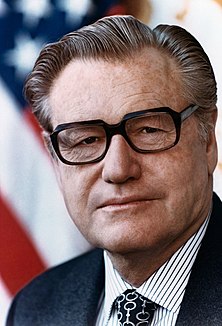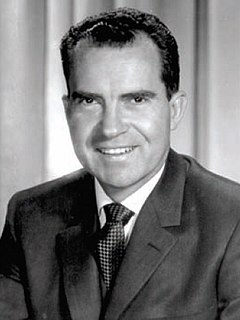
The Rockefeller Republicans, also called Moderate or Liberal Republicans, were members of the Republican Party (GOP) in the 1930s–1970s who held moderate-to-liberal views on domestic issues, similar to those of Nelson Rockefeller, Governor of New York (1959–1973) and Vice President of the United States (1974–1977). Rockefeller Republicans were most common in the Northeast and industrial Midwestern states, with their larger moderate-to-liberal constituencies, while they were rare in the South and West.
A political realignment, often called a critical election, critical realignment, or realigning election, in the academic fields of political science and political history, is a set of sharp changes in party ideology, issues, party leaders, regional and demographic bases of power of political parties, and the structure or rules of the political system, such as voter eligibility or financing. The changes result in a new political power structure that lasts for decades, replacing an older dominant coalition. Scholars frequently invoke the concept in American elections and occasionally those of other countries. American examples include the 1896 United States presidential election, when the issues of the American Civil War political system were replaced with those of the Populist and Progressive Era, and the 1932 United States presidential election, when the Populist and Progressive Eras were replaced by the New Deal-era issues of New Deal liberalism and modern conservatism.

In American politics, the Southern strategy was a Republican Party electoral strategy to increase political support among white voters in the South by appealing to racism against African Americans. As the civil rights movement and dismantling of Jim Crow laws in the 1950s and 1960s visibly deepened existing racial tensions in much of the Southern United States, Republican politicians such as presidential candidate Richard Nixon and Senator Barry Goldwater developed strategies that successfully contributed to the political realignment of many white, conservative voters in the South who had traditionally supported the Democratic Party rather than the Republican Party. It also helped to push the Republican Party much more to the right.
Kevin Price Phillips is an American writer and commentator on politics, economics, and history. Formerly a Republican Party strategist before becoming an Independent, Phillips became disaffected with the party from the 1990s, and became a critic. He is a regular contributor to the Los Angeles Times, Harper's Magazine, and National Public Radio, and was a political analyst on PBS' NOW with Bill Moyers.

What's the Matter with Kansas? How Conservatives Won the Heart of America (2004) is a book by American journalist and historian Thomas Frank, which explores the rise of populist anti-elitist conservatism in the United States, centering on the experience of Kansas, Frank's native state. In the late 19th century, says Frank, Kansas was known as a hotbed of the left-wing Populist movement, but in recent decades, it has become overwhelmingly conservative. The book was published in Britain and Australia as What's the Matter with America?

Richard Art Viguerie is an American conservative figure, pioneer of political direct mail and writer on politics. He is the current chairman of ConservativeHQ.com.
The Conservative Coalition was an unofficial Congressional coalition founded in 1937, which brought together the conservative wing of the Republican Party and the conservative wing of the Democratic Party. According to James T. Patterson: "By and large the congressional conservatives agreed in opposing the spread of federal power and bureaucracy, in denouncing deficit spending, in criticizing industrial labor unions, and in excoriating most welfare programs. They sought to 'conserve' an America which they believed to have existed before 1933."

The Republican Party, also referred to as the GOP, is one of the two major political parties in the United States. It is the second-oldest extant political party in the United States; its chief rival, the Democratic Party, is the oldest.
Modern liberalism in the United States is the dominant version of liberalism in the United States. It combines ideas of civil liberty and equality with support for social justice and a regulated market economy. Economically, modern liberalism opposes cuts to the social safety net and supports a role for government in reducing inequality, providing education, ensuring access to healthcare, regulating economic activity and protecting the natural environment. This form of liberalism took shape in the 20th century United States as the franchise and other civil rights were extended to a larger class of citizens. Major examples include Theodore Roosevelt's Square Deal and New Nationalism, Woodrow Wilson's New Freedom, Franklin D. Roosevelt's New Deal, Harry S. Truman's Fair Deal, John F. Kennedy's New Frontier and Lyndon B. Johnson's Great Society.
Benjamin Joseph Wattenberg was an American author, neoconservative political commentator and demographer, associated with both Republican and Democratic presidents and politicians in the 1960s, ‘70s, and ‘80s.
The Fifth Party System is the era of American national politics that began with the New Deal in 1932 under President Franklin D. Roosevelt. This era of Democratic Party-dominance emerged from the realignment of the voting blocs and interest groups supporting the Democratic Party into the New Deal coalition, following the Great Depression, with most black voters switching from the GOP to the Democratic Party and some conservative, white southern Democrats shifting to the Republican Party as the Democratic party became known as the party of civil rights. For this reason, it is often called the "New Deal Party System". It followed the Fourth Party System, usually called the Progressive Era, and was followed by the Sixth Party System. However, the beginning of the Sixth Party System is disputed.

Political ideologies in the United States include various ideologies and ideological demographics in the United States. Citizens in the United States generally classify themselves as adherent to positions along the left–right political spectrum as either liberal, progressive, moderate, or conservative. Modern American liberalism aims at the preservation and extension of human, social and civil rights as well as the government guaranteed provision of positive rights. It combines social progressivism and to some extent ordoliberalism and is highly similar to European social liberalism. American conservatism commonly refers to a combination of economic liberalism and social conservatism. It aims at protecting the concepts of small government and individual liberty while promoting traditional values on some social issues.
Movement conservatism is an inside term describing conservatism in the United States and New Right. According to George H. Nash (2009) the movement comprises a coalition of five distinct impulses. From the mid-1930s to the 1960s, libertarians, traditionalists, and anti-communists made up this coalition, with the goal of fighting the liberals' New Deal. In the 1970s, two more impulses were added with the addition of neoconservatives and the religious right.

The Reagan Era or Age of Reagan is a periodization of recent American history used by historians and political observers to emphasize that the conservative "Reagan Revolution" led by President Ronald Reagan in domestic and foreign policy had a lasting impact. It overlaps with what political scientists call the Sixth Party System. Definitions of the Reagan Era universally include the 1980s, while more extensive definitions may also include the late 1970s, the 1990s, the 2000s, the 2010s, and even the 2020s. In his 2008 book, The Age of Reagan: A History, 1974–2008, historian and journalist Sean Wilentz argues that Reagan dominated this stretch of American history in the same way that Franklin D. Roosevelt and his New Deal legacy dominated the four decades that preceded it.

Richard Montgomery Scammon was an American author, political scientist and elections scholar. He served as Director of the U.S. Bureau of the Census from 1961 to 1965. Afterwards, he worked for decades directing election analysis for NBC News.

This timeline of modern American conservatism lists important events, developments and occurrences which have significantly affected conservatism in the United States. With the decline of the conservative wing of the Democratic Party after 1960, the movement is most closely associated with the Republican Party (GOP). Economic conservatives favor less government regulation, lower taxes and weaker labor unions while social conservatives focus on moral issues and neoconservatives focus on democracy worldwide. Conservatives generally distrust the United Nations and Europe and apart from the libertarian wing favor a strong military and give enthusiastic support to Israel.
The Coalition for a Democratic Majority (CDM) was a centrist faction, active in the 1970s within the Democratic Party of the United States.

The 1972 United States presidential election in Florida was held on November 7, 1972, as part of the concurrent United States presidential election. Florida voters chose seventeen electors, or representatives to the Electoral College, who voted for president and vice president.

The 1960 United States presidential election in Wisconsin was held on November 8, 1960 as part of the 1960 United States presidential election. State voters chose 12 electors to the Electoral College, who voted for president and vice president.

The 1952 United States presidential election in Florida took place on November 4, 1952, as part of the 1952 United States presidential election. Florida voters chose ten representatives, or electors, to the Electoral College, who voted for president and vice president.












